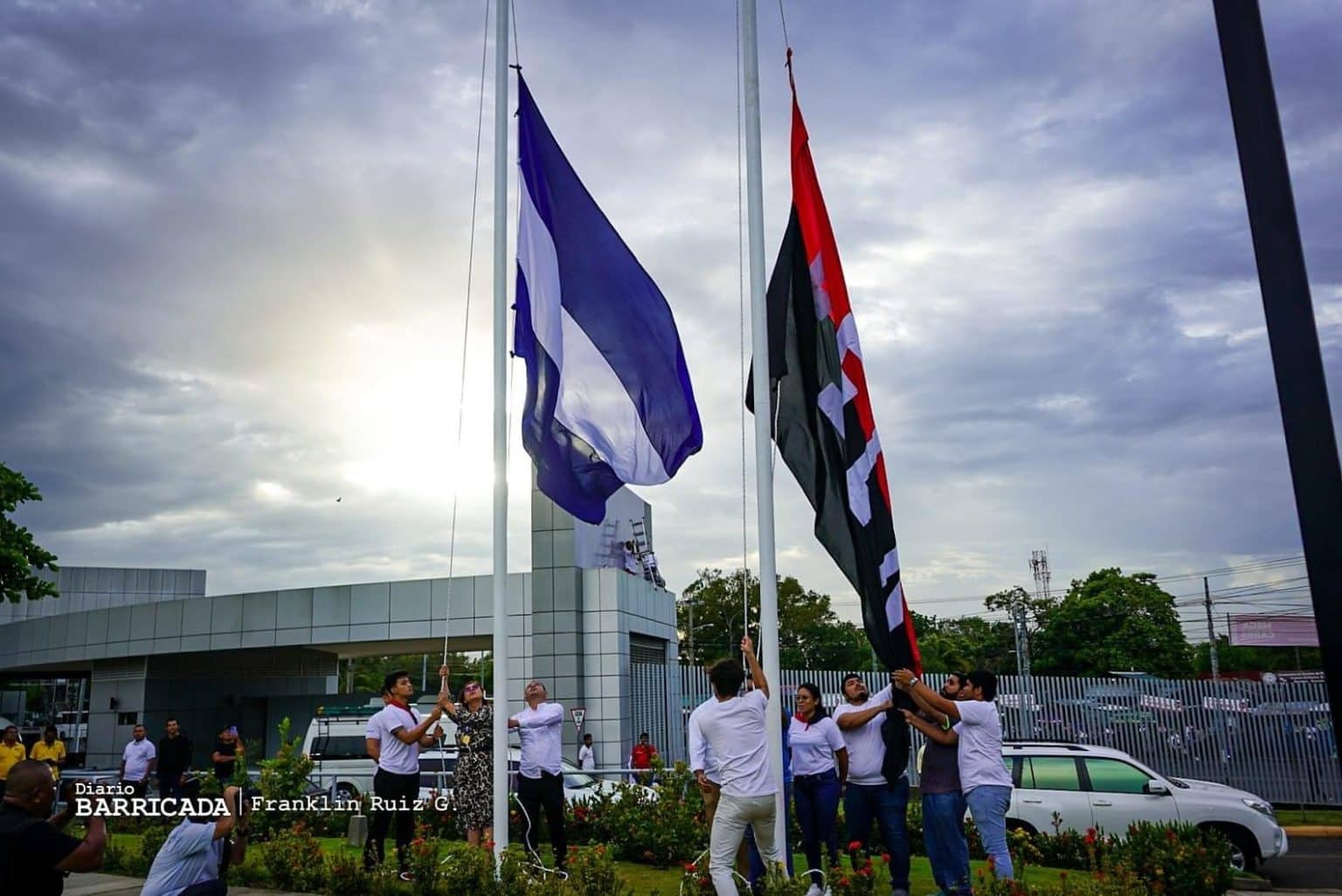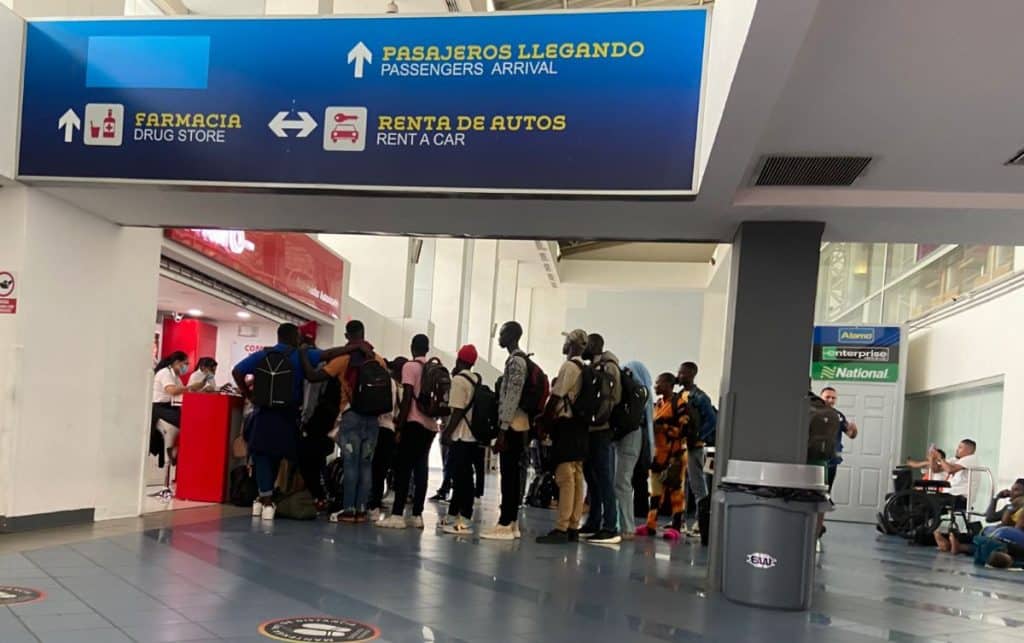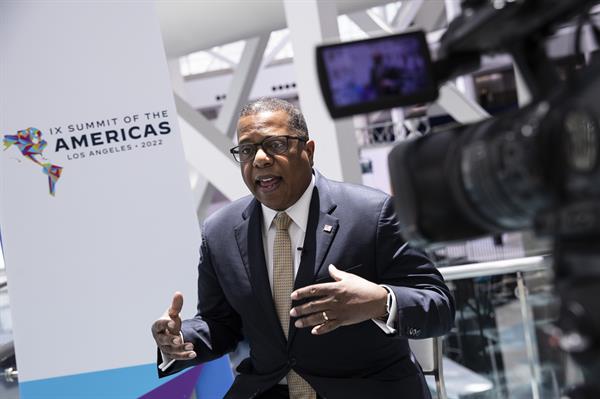14 de noviembre 2023

European Concern over Lack of Academic Freedom in Nicaragua

PUBLICIDAD 1M
PUBLICIDAD 4D
PUBLICIDAD 5D
The Nicaraguan Immigration Service triples its revenues by charging $150 to each migrant who passes through Nicaragua en route to the U.S.

Fotoarte: Confidencial
Venezuelan Yeleida Quintero, 50, thought that crossing the Darien Gap in Panama would be the hardest part of the more than 4,500-kilometer journey to the United States. And although it was tough to navigate, when she arrived in Nicaragua she learned that the jungle was not necessarily the worst part of the trip.
Quintero was traveling with two of her children and two grandchildren, and was forced to pay $150 each to enter and pass through Nicaragua to continue on her way north. She paid a total of $750, thirty times the $25 monthly salary she earned as a nurse in Venezuela.
"There are people who are more dangerous than even the jungle itself," Quintero said, frustrated by the situation.
The "fine" that the Venezuelan migrant had to pay in Nicaragua is the new revenue-raising business installed by Daniel Ortega's dictatorship, boosting the income of Nicaragua's DGME (Immigration Administration) by taking advantage of the migration crises in several countries in Latin America, the Caribbean, Africa and other regions.
According to an estimate by CONFIDENCIAL, between January and October 2023, the DGME has received some $65.9 million from fines on migrants passing through the country on their way to the United States. The calculation is based on the number of irregular migrants reported by Honduras at four crossing points on the border with Nicaragua.
"They took away what little we had," the Venezuelan migrant told the EFE news agency, shortly before boarding a bus that would take her and her family to Agua Caliente, on the border between Honduras and Guatemala. She was barely halfway to the United States.

On November 6, U.S. State Department Assistant Secretary for Western Hemisphere Affairs Brian A. Nichols expressed his country's concern "over reports of a dramatic increase in charter flights to Nicaragua that facilitate irregular migration from Cuba and elsewhere to the United States."
In a thread on his account on X (formerly Twitter), Nichols added that "no one should profit from the desperation of vulnerable migrants...not smugglers, not private companies, not public officials, not governments."
Nichols also warned that the United States is "exploring the full range of possible consequences for those who facilitate this form of irregular migration," after urging migrants "to use safe and legal avenues."
Daniel Ortega's dictatorship is not only facilitating this irregular migration, it is also generating millions of dollars in revenue by charging $150 or $200 to each migrant, under the guise of a "safe passage” travel permit that does not actually exist in Nicaragua.

Nicaragua has not reported on either the number or the nationalities of migrants that have passed through the country so far in 2023. But the presence of migrants is evident at the Managua international airport and other travel terminals. Recently, thousands of Haitians were seen arriving at the airport aboard commercial flights when 36 such flights landed in Managua from Port-au-Prince over the course of only three days.
To estimate how many migrants are using Nicaragua as a pass-through, CONFIDENCIAL consulted statistics from the Honduran National Migration Institute. Between January and October 2023, the Institute reported that 440,203 irregular migrants entered its territory. Of these, 439,972 (99.59%) were identified as crossing in Cami Danlí, Trojes, Danlí and Choluteca, near the Nicaraguan border posts of Las Manos, El Espino and Guasaule. In other words, they are migrants who had come through Nicaragua, and it can be assumed that most of them had paid the "fine" imposed by the DGME.
According to official data from the Honduran government, 187,902 (42%) of the migrants who entered its territory were of Venezuelan origin. Meanwhile, another 73,188 (17%) were Haitians, 64,818 (15%) were Cubans, and 38,964 (9%) were Ecuadorians. These are the same four nationalities that are currently using Nicaragua as a migratory "bridge," and that have most denounced arbitrary fees by Nicaraguan authorities.

Migrants crossing through Nicaragua are required by immigration authorities to pay US$150 or US$200 for a "salvoconducto", a supposedly temporary transit permit, which does not exist in Nicaragua.
The fee, in reality, is a type of fine for "entry and exit through an unauthorized border post," which was added to the General Migration and Foreigners Law in 2020. The government does not issue any document or receipt for these payments, resulting in some officials trying to charge the same fee twice, according to complaints from different groups of migrants.
This new fine was introduced into the law at the same time as the dollarization of all immigration services for foreigners. CONFIDENCIAL verified that the implementation of this law has dramatically increased the revenue collected by the DGME.
In 2019 –when the fine did not yet exist– the DGME collected $7.7 million. The amount doubled in 2021, when more than $16.9 million was collected, according to CONFIDENCIAL's review of official budget execution reports from 2018 to June 2023. In the regime's reports, this income is recorded only as "other fees for immigration and non-citizen services," but it coincides with the growth in the flow of irregular migrants reported in Honduras.
The revenue collected by the DGME has been growing steadily, as has the number of migrants passing through Nicaragua on their way to the United States.
In 2022, the DGME reported revenues from "other service fees" of over $26.8 million, 3.6 times more than its 2019 reported revenues.
The trend has continued in 2023. During the first half of the year, the DGMEreported $18.5 million in revenues. This coincides with the flow of migrants into Honduras: In the same period, Honduras reported 135,493 irregular migrants of all nationalities. If each of these migrants had been processed in Nicaragua –and therefore subject to the $150 fine–, the government would have received $20.3 million, a figure quite close to that reported by the DGME.
Based on that calculation, the more than 439,900 migrants who have arrived in Honduras between January and October 2023 through border posts with Nicaragua would have earned the dictatorship some $65.9 million, based on a collection of $150 per migrant. At $200 per migrant, the total would be $87.9 million.

The Central Bank of Nicaragua reports that since 2021, when Ortega relaxed immigration requirements for Cubans, the international airport has received more visitors arriving in the country who are not registered as leaving. This suggests that they are migrants who are using Nicaragua as a "trampoline," or migratory "bridge."
The Central Bank reported 634,000 travelers who entered and passed through the airport in 2022. Of those, 322,000 didn't leave again through the airport. In 2023, as of August, 476,000 visitors have arrived at the airport. Of those, it is likely at least 100,000 continued on their journey north towards the U.S.
While other countries have tightened their immigration restrictions in an attempt to curb massive migration from these two Caribbean countries, Nicaragua offers them visa-free travel and a strategic geographical position on the route to the U.S., especially for those who want to avoid Panama's dangerous Darien Gap.
Since January 2023, Nicaragua has been a "bridge" for almost 100,000 Cuban and Haitian migrants who have arrived in Managua on charter flights to then continue on by land to the United States, according to estimates by Manuel Orozco, researcher at the Inter-American Dialogue.
"Flight data from August to October point to more than 260 flights with more than 30,000 Haitians. This accounts for almost 60% of all Haitian arrivals at the U.S. border," Orozco explained in his article, "An Unprecedented Migration Crisis: A characterization and analysis of how deep the crisis is."
Orozco also points out that so far in 2023, some 50 flights per month have arrived in Managua from Havana, Cuba. These have brought approximately 5,700 passengers, representing 40% of the number of Cuban arrivals at the U.S.-Mexico border.
"A booming business transformed Nicaragua into an air base to receive a large number of flights from Europe, Latin America, and the Caribbean with a large number of irregular Cuban, Haitian, African and Asian migrants who manage to bypass the Darien Gap and use Managua as a point of origin for their land crossing to Mexico and the United States," according to the Mexican newspaper El Universal, in its November 8th report "Nicaragua joins the migration business in America," published a couple of days after this CONFIDENCIAL article.
The Mexican newspaper quotes a report from October 2023, provided by the United Nations International Organization for Migration, which indicates that the number of Cubans, Haitians and Africans in transit through Panama decreased from January to September of this year, but increased through Honduras, as evidenced in the above-mentioned data from the Honduran government.
While these statistics are evidence of Daniel Ortega's multi-million dollar business, each figure represents the story of a person who had to leave everything behind in search of a better quality of life: a family that almost died in the jungle, a woman who sold the few belongings she had to buy the ticket that would bring her closer to the "American dream," or the many who had to wait for days at the border –without shelter– until they could raise $150 or $200 each to continue their journey.
In August 2022, two groups of 118 Venezuelan migrants who entered Nicaragua by sea from the Colombian island of San Andres reported to CONFIDENTIAL that they had been stripped naked in order to rob them of the $150 payoffs.
"I had $170 for the trip and I happily gave them $20, calculating that I would have enough left over for the rest of the trip, but when they stripped my clothes off, they found the other $150, so they gave me back the $20 bill and took the $150," migrant Luis Alfredo Gonzalez told CONFIDENCIAL.
"They are corrupt. It takes so much sacrifice to leave Venezuela, and then to have government officials steal from you? It's disgusting," lamented Gonzalez.
This article was originally published in Spanish in Confidencial and translated by our staff. To get the most relevant news from our English coverage delivered straight to your inbox, subscribe to The Dispatch.
PUBLICIDAD 3M
Confidencial es un diario digital nicaragüense, de formato multimedia, fundado por Carlos F. Chamorro en junio de 1996. Inició como un semanario impreso y hoy es un medio de referencia regional con información, análisis, entrevistas, perfiles, reportajes e investigaciones sobre Nicaragua, informando desde el exilio por la persecución política de la dictadura de Daniel Ortega y Rosario Murillo.
PUBLICIDAD 3D